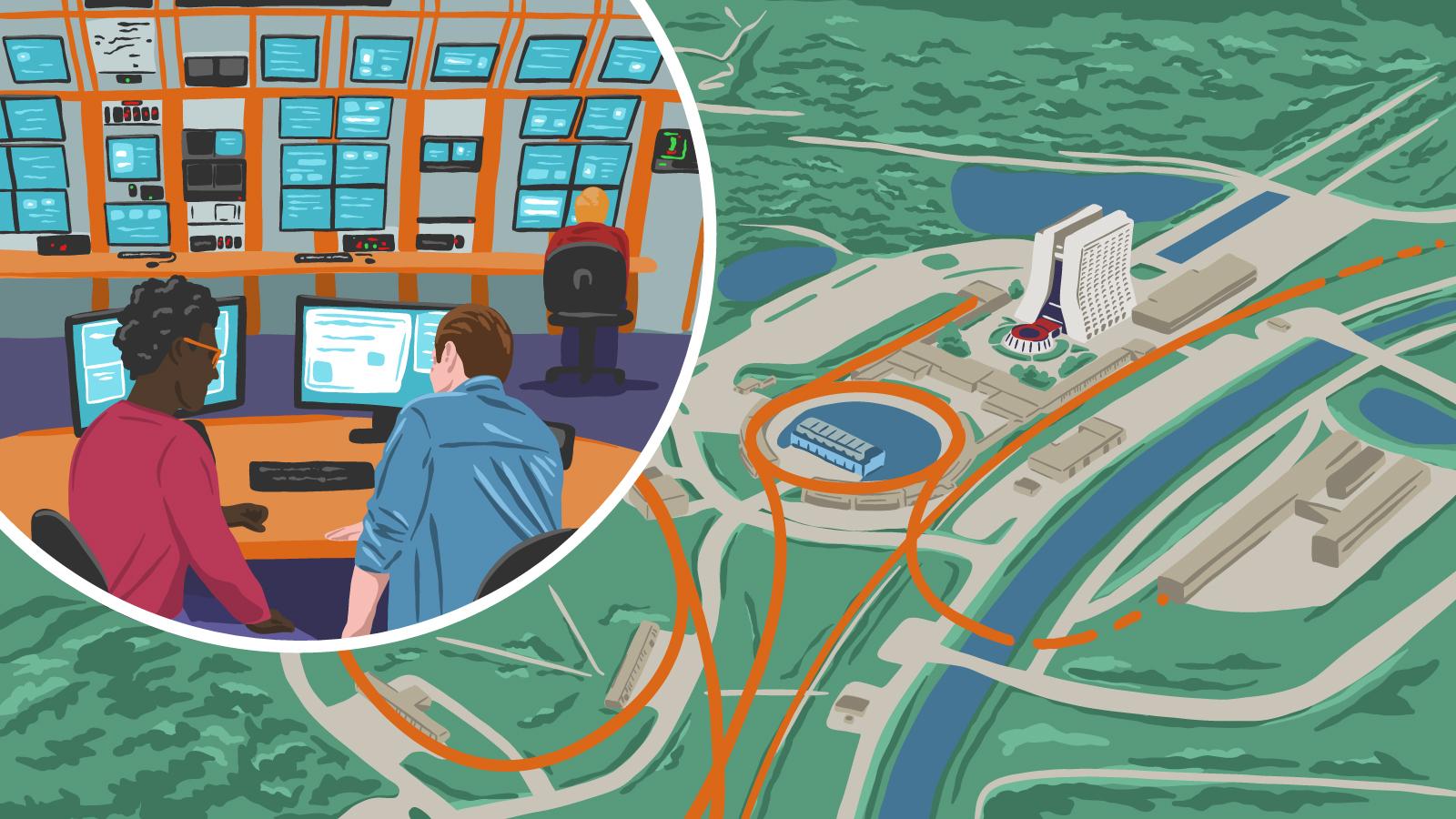Despite the fact that accelerator operators are essential to keeping an accelerator laboratory afloat, the role is largely unknown outside of physics—even to the people who wind up in the job.
“It was a kind of position that I wasn’t familiar with or knew even existed before,” says Judah O’Neil, who for the last two years has worked at the US Department of Energy’s Fermi National Accelerator Laboratory.
At Fermilab, accelerator operators are responsible for maintaining and running the machinery needed to provide beams of particles to all the experiments around the lab.
“The cool factor of this job is just off the charts.”
It all starts with the 500-foot linear accelerator, or Linac, which operators use to give a beam of protons their first kick. From the Linac, the proton beam heads to the Booster, a 1,500-foot circular accelerator that increases the energy of the beam. From there, operators can direct the beam to different parts of the complex, including Fermilab’s neutrino and muon experiments.
By steering protons from the Booster into a target, operators can create beams of low-energy neutrinos for neutrino experiments. Operators can also transfer a beam from the Booster into the 2-miles-in-circumference Recycler instead to change its composition or produce beams of muons for muon experiments. Transferring protons from the Recycler to the Main Injector, the next step along the line, allows operators to ramp up the energy even more. They use the Main Injector, also 2 miles in circumference, to produce the world’s highest-intensity neutrino beam for long-baseline neutrino experiments.
The PIP-II construction project, currently underway, will increase the capabilities of the entire accelerator complex with a brand-new 700-foot linear superconducting accelerator.
All of this, along with maintenance of the separate parts of the accelerator complex, goes through the accelerator operators in Fermilab’s Main Control Room.
Each group of operators, led by a crew chief, rotates through day, evening and overnight shifts to keep the control room staffed 24/7. “[Having rotating shifts] allows you to know everyone and get experience at different times during the day,” O’Neil says. “You get to be in the control room and talk to the experts, see what’s going on, and meet everyone.”
Working in the control room requires operators to multitask. They must keep track of multiple monitors at their individual consoles, along with bigger screens that display to the whole room an overall system status and a weather radar—since the accelerator complex can be affected by storms. Beeps and blips and other sound effects provide auditory cues that can cut through the noise of people coming in to check out access keys, inform operators of an issue, or just pop by for a quick hello. If something goes wrong, operators are the ones to head out to investigate and either solve the problem or find a more senior operator who can.
Operators don’t learn how to manage these responsibilities overnight. They go through a training period that lasts through their first two years on the job.
“You aren’t even assigned to a crew for your first month because you’re just getting through some initial training,” says Laura Bolt, who has been an operator since November 2021. “For the first year to two years that you’re here, your primary objective is to finish that training and also be helpful in the control room.”
Once operators complete their on-the-job training, or OJTs, they can then either specialize in a specific area or help train newer operators.
“When you start, you are doing things, but it’s usually with supervision or you’re watching somebody do something so you learn how to do it,” says Cassidy Mayorga, who has been an operator for four years. “Then you slowly shift into doing it on your own, and then you shift into doing it to teach other people.”
Mayorga serves on the training committee and helps make sure training documentation is up-to-date.
Completing OJTs involves studying instruction manuals and taking written tests, supplemented by in-person instruction from senior operators.
Because so much of an operator’s training comes from collaboration and getting hands-on experience with supervision, the pandemic had a significant impact on the Main Control Room at Fermilab. The usual hustle and bustle came grinding to a halt as operators acclimated to new schedules and skeleton crew shifts to allow for social distancing. “It was a big adjustment,” Mayorga says. “It was very quiet and kind of unnerving.”
For operators who were hired during the pandemic, the gradual lifting of restrictions and more recent return to semi-normal daily operations gave them a new appreciation for their colleagues’ expertise.
“It’s really good to have those conversations with the experts and be able to have a lot of people in the control room at once because you get different opinions, you get to learn a lot of things,” O’Neil says.
The operators are a diverse group. Some of them have known that they wanted to work at Fermilab since they were young, others stumbled across the position just by chance. There are writers, like Bolt; amateur astronomers, like O’Neil; and Ultimate Frisbee enthusiasts, like Mayorga. Many share at least one interest: video games.
Bolt, O’Neil and Mayorga all say that being an operator is a great gig for those interested in the hands-on elements of particle physics, including those who don’t plan to follow the usual path straight through a physics PhD. “The cool factor of this job is just off the charts,” Bolt says. “This is the perfect place for non-traditional physics students.”







